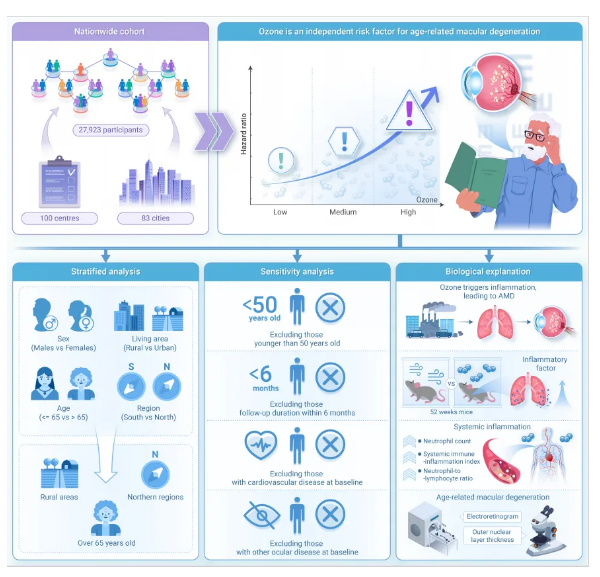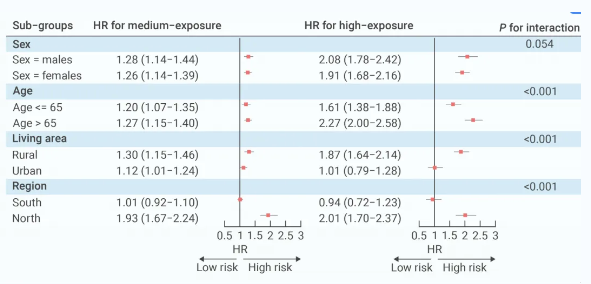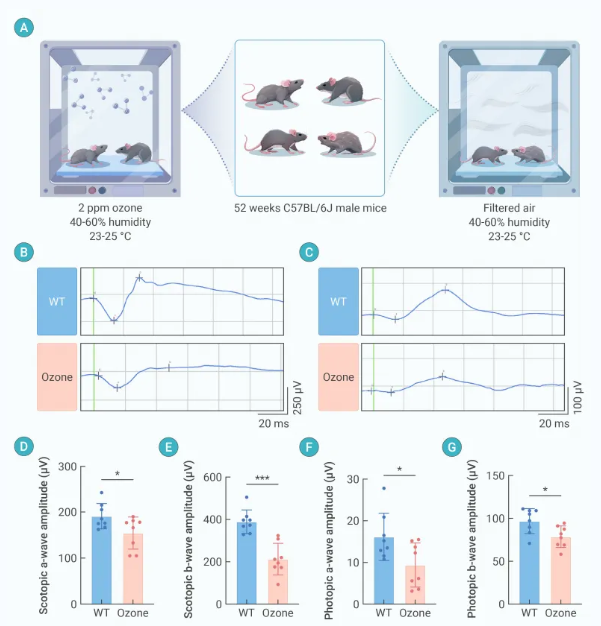- News
Professor Sun Xiaodong’s Team Publishes Research on “Ozone Pollution Leading to Age-Related Macular Degeneration” in The Innovation
https://mp.weixin.qq.com/s/lB01TLgD_NfbQuZNSPSiaw
Frontier Research
Ozone pollution has been confirmed to be closely related to various age-related diseases, such as cardiovascular and respiratory diseases. However, little research has been conducted on whether ozone pollution also affects age-related macular degeneration (AMD), the leading cause of irreversible blindness in the elderly. This knowledge gap prompted the authors to undertake this study, aiming to provide new scientific insights into visual health.
Professor Sun Xiaodong’s team at Shanghai General Hospital, affiliated with Shanghai Jiao Tong University School of Medicine, has published their research in The Innovation (Impact Factor: 33.2, CAS Tier 1):
“Ozone exposure and increased risk of age-related macular degeneration: Evidence from nationwide cohort and toxicological studies.”

[Figure 1: Graphical Abstract]
Research Background
Ground-level ozone is a colorless gaseous pollutant, and China has been facing an increasingly severe ozone pollution problem in recent years, with its average levels significantly exceeding the air quality standards recommended by the World Health Organization. Meanwhile, AMD is the leading cause of irreversible blindness among the elderly. Currently, research on the impact of ozone pollution on AMD remains limited.
This study, by combining cohort analysis and toxicological experiments, is the first to clarify the temporal relationship and potential biological mechanisms between ozone pollution and AMD. It also proposes a novel population-based prevention and control strategy for AMD.
Experiments and Research
The study consists of two parts:
A prospective cohort study to establish the temporal relationship between ozone pollution and AMD.
A toxicological study to explore the underlying biological mechanisms (Figure 2).
The prospective cohort study included 27,923 participants from 100 centers across 83 cities. Participants were categorized into three groups based on their ozone exposure levels: low, medium, and high exposure groups. The study plotted an ozone exposure-response curve and conducted sensitivity analyses to validate the robustness of the results. Additionally, stratified analyses were performed to identify high-risk populations requiring targeted protection.
In the toxicological study, 52-week-old male mice were randomly assigned to two groups: one exposed to inhaled ozone and the other to clean air. After ozone exposure, the mice exhibited functional and anatomical damage to their vision. For the first time, the study deciphered how external ozone penetrates multiple barriers to reach the innermost layer of the eye—the retina—through the pathway of "ozone-induced lung inflammation → systemic circulation → retinal damage."

[Figure 2: Research Design]
Key Findings
The exposure-response curve followed a J-shaped trend, showing that as ozone concentration increased, the risk of developing AMD significantly rose (Figure 3). After adjusting for age, gender, region, residential area, smoking, and cardiovascular disease history, every standard deviation increase in ozone concentration was associated with a 23% increase in AMD risk. Individuals in the high ozone exposure group had twice the risk of developing AMD compared to those in the low exposure group.

[Figure 3: Exposure-Response Curve]
Further stratified analysis revealed that the harmful effects of ozone on AMD were amplified in individuals over 65 years old, those living in northern China, or those residing in rural areas (Figure 4). The study suggests that older adults may be more susceptible due to weakened immune responses to pollution-induced inflammation, reduced antioxidant capacity, and impaired cellular repair mechanisms, making them more vulnerable to oxidative damage.

[Figure 4: Stratified Analysis]
Toxicological Findings
In mouse experiments, compared to the clean air group, the ozone-exposed mice exhibited decreased retinal electrophysiological function. Specifically, the average amplitudes of dark-adapted a-waves and b-waves in the ozone-exposed group were 154.4 μV and 212.5 μV, respectively, while those in the clean air group were 190.9 μV and 389.5 μV (Figure 5).

[Figure 5: Decline in Visual Function in Ozone-Exposed Mice]
Future Perspectives
This study is the first to establish the temporal relationship between ozone exposure and AMD through a nationwide prospective cohort study, further exploring its biological mechanisms via toxicological experiments in animals. The findings provide a novel perspective on how air pollution impacts retinal health and emphasize the urgent need to reduce ozone pollution to alleviate the increasing burden of AMD among aging populations.
